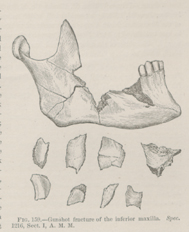Title: F——, R. J.
Source text: Surgeon General Joseph K. Barnes, United States Army, The Medical and Surgical History of the War of the Rebellion. (1861–65.), Part 1, Volume 2 (Washington, D.C.: Government Printing Office, 1870), 349.
Civil War Washington ID: med.d1e17886
TEI/XML: med.d1e17886.xml
CASE.—>Corporal R. J. F——, Co. F, 60th New York Volunteers, aged 22 years, was wounded at the battle of Fredericksburg, May 3d, 1863, by a conoidal ball, which fractured the superior and inferior maxilla. The ball entered the ala of the nostril, and passed downward and backward, splitting the ramus of the inferior maxilla, and emerged by two openings in front and below the pinna of the right ear. The superior maxilla of right side was destroyed, and the right portion of the inferior fractured and comminuted, and fissures running into the orbital process. He was, on May 7th, admitted to Carver Hospital, Washington. Cold water dressings and bandages were applied. Slight hæmorrhage from the internal maxillary artery occurred at ten and eleven o'clock P. M., May 9th, which yielded to compression; it again recurred profusely at twelve o'clock, amounting to about fifty fluid ounces of blood; attempts at compression of the carotid artery were unsuccessful, the patient being unmanageable from fear; during the remainder of the night and the day following, he was kept in a sitting posture, and ice retained in his mouth, and strictly forbidden to speak. At two o'clock P. M. on the 11th, his pulse being on the increase, six drops of the tincture of aconite was ordered. The hæmorrhage returned in the evening, the patient became frantic with alarm, and prevented all attempts at compression. He died immediately. The autopsy revealed great comminution of the superior and inferior maxilla, and that the hæmorrhage proceeded from the trunk of the internal maxillary artery. The specimen is figured in the wood-cut. The case is reported by Acting Assistant Surgeon E. F. Bates.
